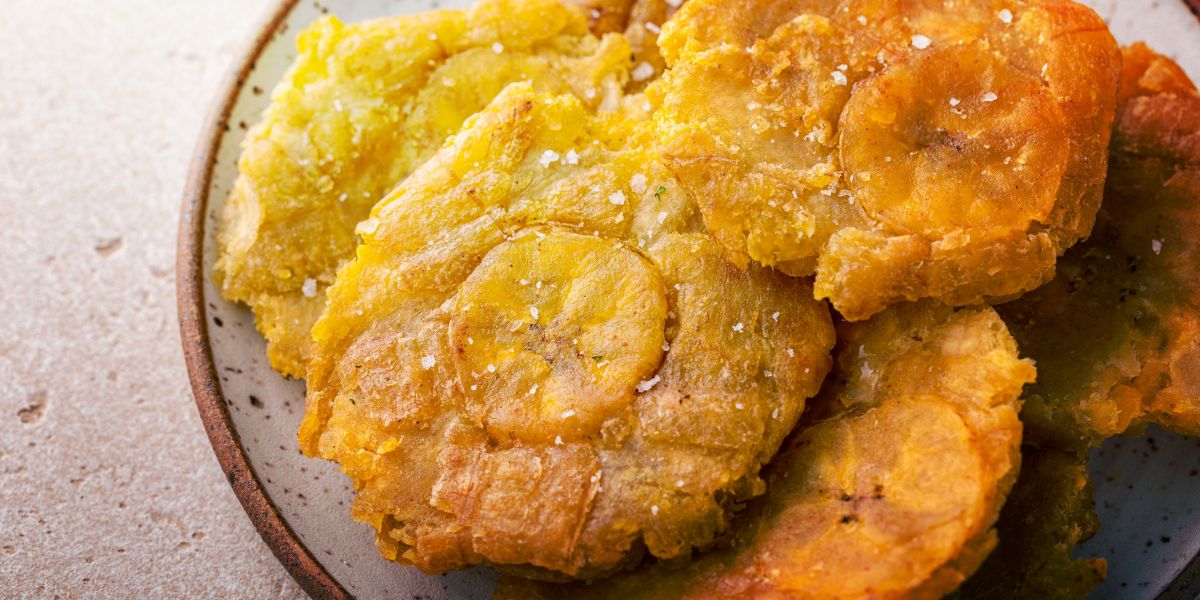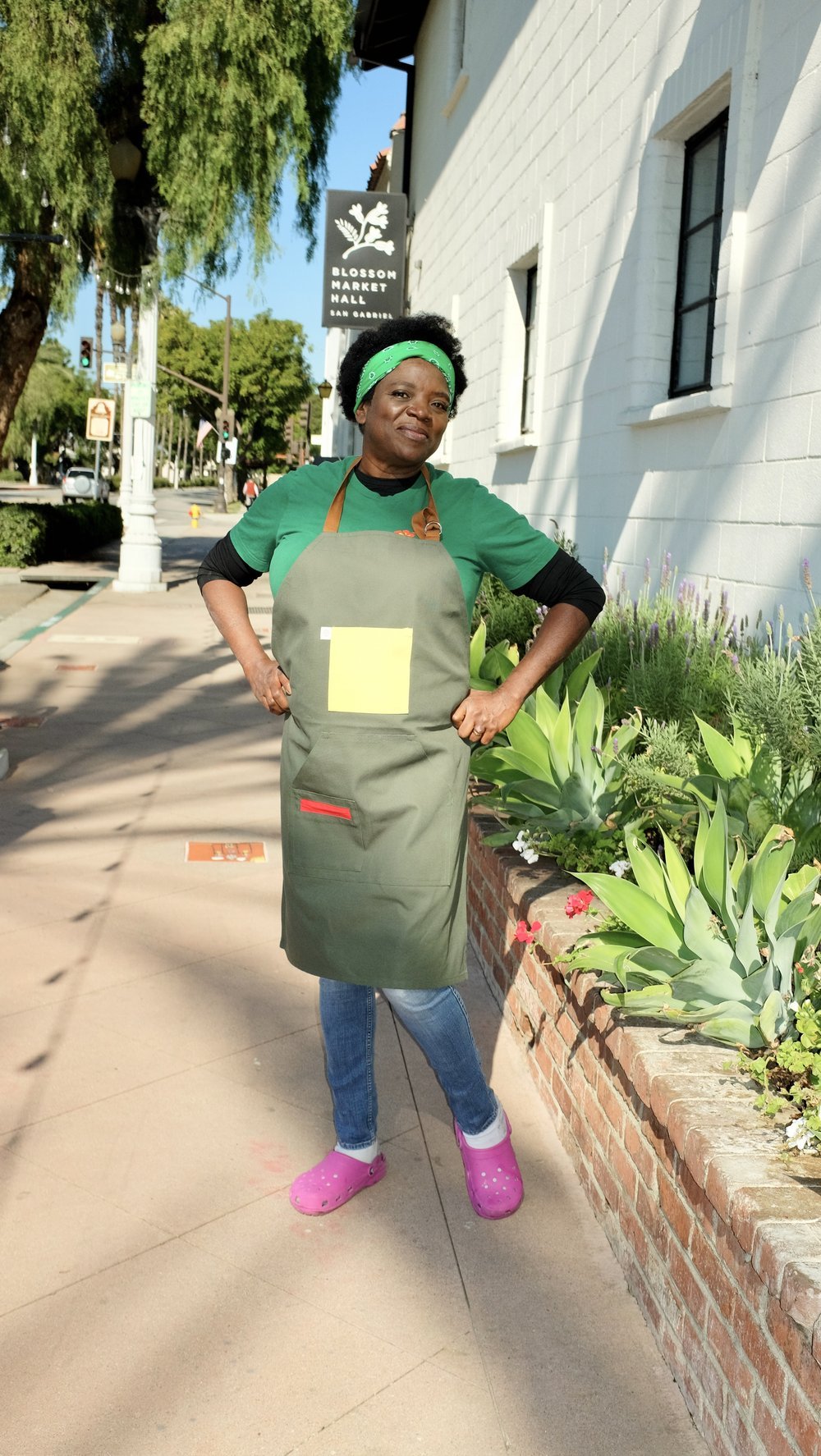Yonette Alleyne
Episode 126
A Passion for Providing, No Matter What
Yonette Alleyne is the lovely woman behind Caribbean Gourmet. When she was young at home in Guyana, she found what she loved to do early in life. She asked her mother for a cookbook for her 11th birthday and has been cooking, baking, and refining her talent ever since. In Guyana, she had run her own business, and she knew she had the skills to survive. Her skills had come from her own mother and grandmother, as Yonette had assisted her grandmother in the kitchen, making peppermint candies, jams, jellies, cakes, and pastries.
When Yonette and her family moved to Los Angeles, she found it to be a bit of a new challenge after being a business owner in control of her own fate. After nine months of searching and applying for jobs, Yonette worked as a cake decorator at a Los Angeles supermarket. Within nine months of working that job, she became a manager and began training others, staying for nine years and then becoming a bakery manager at another location for five years.
In 2015, Yonette started her business at the Farmers’ Markets in Los Angeles. She was at Crenshaw/Baldwin Hills and Atwater Village. Her business started with a variety of handmade Caribbean pastries and fruit drinks. After about six months in business, she slowly added a variety of hot food dishes as customers requested.
Yonette grew their Instagram following by posting regularly and showcasing hard-to-find Caribbean dishes. At the beginning of the pandemic, the Farmers’ Markets were closed for a little while. Being mainly a family business, she decided to offer meal delivery. She would cook, pre-pack, and deliver the food for a small fee in about a 35-mile radius.
In December 2021, Yonette opened her first brick-and-mortar location in the Blossom Market Food Hall in the City of San Gabriel. That was one of her dreams of opening her own restaurant. She gets so much support from longtime and new customers, and she is enjoying this new experience.
Today, she has many loving followers who will travel far to get her special food featuring Caribbean favorites like oxtail stew, jerk chicken, chicken curry, vegan curry, beef and turkey patties, and pastries baked from scratch.
Yonette Alleyne Takeaways
- Yonette’s culinary journey began in Guyana, where she initially had little exposure to cooking.
- Her interest began when she received a chef’s coat, hat, mittens, and a cookbook on her eleventh birthday. This ignited her passion for baking and eventually led her to begin a career in the restaurant industry.
- Seeking more control over her time, Yonette started her own food business.
- She began at farmers’ markets and built strong relationships with the community, leading to the success and expansion of her business.
- She then opened a space in Blossom Market, though she initially had reservations about the neighborhood’s reception to Caribbean cuisine. Her restaurant specializes in Caribbean cuisine, known for its well-seasoned and flavorful dishes.
Yonette Alleyne Quotes
- “I was married very young and didn’t know how to cook. My husband was doing most of the cooking. It took me three years to finally learn to make a meal. He never complained. We still talk about it, and my friends always say, you got married, didn’t know how to cook, taught yourself, and looked how you opened a business with food.”
- “On my birthday, she gave it to me with a cookbook. And I was thrilled. It was the best gift. I remember baking cupcakes right away, and I forgot to put baking powder. And my siblings, they teased me about it. They were laughing because they were like hockey pucks.”
- “Then we opened with a bang. I don’t know what changed, but people came. We couldn’t keep up. We were blown away by the response we got when we opened. And it continues to now that we get so much support from the SGV community. It’s exceeded our expectations.”
Show Notes
Where are you from?
I’m from South America, but we are considered a Caribbean country. We are part of the West Indies, and we’re all part of one community called CARICOM, which means Caribbean Community. Guyana is the headquarters for the whole Caribbean. So, we are considered Caribbean even though we are in America.

How many Guyana’s are there?
There are three. There’s the French Guyana. Where I’m from was formerly British Guyana. It’s now Guyana and then Dutch. Guyana is Suriname.
Is there a Guyana population in the San Gabriel Valley?
Now and again, I meet people from Guyana or other Caribbean nations living in the Gabriel Valley. What has been surprising to me is that Guyana has a relatively large population of Chinese, and many Chinese descendants live in San Gabriel. So they come in, and no one would think they’re from Guyana. And they would see the flag, and they would scream, “Oh, my God, Guyana. That’s where I’m from.”
What is your connection to the San Gabriel Valley?
I came to the United States 25 years ago and moved to Los Angeles. I live 25 to 30 minutes from here in Los Feliz.
What was life like growing up in Guyana?
Growing up in Guyana, there were some very nice things, and some things were a little different. My first memory of Guyana was living on a sugar estate. My father was a personnel manager for the estate. So, the estate had a segregation kind of thing. And when I say that, if you lived on the estate, it’s like a gated community.
People couldn’t come in unless they lived on that estate. And you had to be recruited specially from this company to live there. We had our own club, movie theater, and swimming pool. It was a strange setup, but that’s how it was. And there were many estates, and we lived there for a while.
My father then got recruited by a bauxite company. So we went to another community which had the same kind of setting. The community had a lot of Canadian families. So I grew up learning the history of Canada and Quebec, and I was learning about the beavers and the maple leaves and stuff, maple trees. But I’m a Guyanese kid who went to a Canadian school.
I learned about things like Halloween, which was not celebrated in Guyana. I went trick-or-treating with the neighborhood kids even though I didn’t know what it was.
It was a very upper-class lifestyle, and you never realized how segregated it was until you reached a certain age.
Can you tell us more about how these estates were set up?
My father was a young man and was high-achieving academically. There was a British company in Guyana called Bookers that looked for young people who were going places, and they recruited them and sent them overseas to study.
My father grew up poor in Guyana, and this company, Booker, sent him overseas to study to be an economist. He got his degree, he went back to Guyana, and they sent him to the sugar estate when he got there. He was the personnel manager and had a big, fancy office.
The families enjoyed a lot of perks. You have people coming in, cleaning, you have maids. It’s a lifestyle where you’re treated royally. We got family allowances every year to go on trips.
The Canadian company, Denver, saw my father moving up the ranks and recruited him to come to another city to work for them with the same lifestyle.
Growing up, I didn’t know of things being hard. I didn’t understand people struggling until I became older.
When did you develop your interest in cooking? Were you cooking during this time?
My mother had a very good job, too, and she grew up as an only child, so she was never into cooking. So, growing up, we were never into cooking or working around the house.
I was never allowed in the kitchen. People were always doing it for us.
But on the weekends, my mom cooked for the family, even though we had people to do that. She would cook, and she did well with cooking and baking.
She was an amazing baker, and I always loved to see her make cakes and pastries. I would go into the kitchen and watch, and she would never let me touch anything. She said, “No, don’t touch. You don’t want to do a job like this. You want a nice job in a fancy office.”
She always told me that because I was the only one interested in cooking, she never allowed me because she didn’t want me.
But she never allowed me to cook, never allowed me to touch anything. I could watch her cook, and while I did that, I retained what she was doing.
When I was eleven, she asked me what I wanted for my birthday. And I told her I wanted a chef’s coat, hat, and mittens.
On my birthday, she gave it to me with a cookbook. And I was thrilled. It was the best gift. I remember baking cupcakes right away, and I forgot to put baking powder. And my siblings, they teased me about it. They were laughing because they were like hockey pucks.
I had a friend that I would help bake, and that’s how I started making cakes. When I was 18, I got a contract from two bakeries to make pastries for them.
So I knew how to bake but didn’t know how to cook.
Were you married when you moved to the San Gabriel Valley?
Yes, I got married in Guyana. My husband and three children moved with me to the SGV, and I’ve had one child since we moved here.
What did you do here when you arrived in the San Gabriel Valley?
It was challenging to get a job. It took nine months to find one.
I got a job at Pavilions as a cake decorator because I already knew how to make cakes. And I got hired during the interview.
I worked there for nine years. I worked in different stores, got promoted to bakery manager, and trained the bakers, cake decorators, and donut fryers.
I was a bakery manager there for nine years and then went to another job doing the same kind of work for another four or five years.
Then, I took some time to be home with my kids for a little while, and then I wanted to have more control of my time, so I decided to open up a business.
I looked for the easiest way to start at a farmer’s market because the overheads are less. I started with two immediately and then picked up a third one. And then, after a year, I dropped one and kept two.
Which ones were you at?
The first one I had was one in Hollywood named Barnesdale; that one closed shortly within a year of us being there.
Then we had one in Echo Park, and then we had one in Crenshaw, and then we had one in Atwater Village, and we kept Atwater Village and Crenshaw for seven years.
Did you cook everything at home and bring it to the farmer’s market?
I cooked in an incubator kitchen. I had stoves, ovens, and a steam table. You take the food hot and just put it on the steam table and keep it hot to serve the food, heat the pastries, the drinks.
We would make the drinks and take them there. So we did that for seven years.
It was nice to build the relationships we fostered, and they continue because those people come and drive all the way to see us, and we know each other really well. So, we created that relationship and a tight-knit community.
That must have been hard at first.
It is challenging when you’re a new vendor because nobody knows you, and people don’t trust you if they don’t know who you are and what you’re bringing. The first six months were very tough at Crenshaw. We were at Crenshaw longest because it was a community where people didn’t know us.
By the time I got to Atwater, people knew who we were.
When did you open your space in Blossom Marker?
We got an opportunity to go to Blossom Market. One of our friends, who was a caterer business owner doing similar markets to us, was telling me about Blossom Market, and they were going to go and give me some information. So I called and spoke to the owners, who were excited. They had heard of us, and I think they also had our food. They were excited and said, “Oh, yeah, we’d love to have Caribbean food here.”
They asked me to come and see them. And I went, and I saw the place was all gutted. They showed us around, and I was a little apprehensive because I didn’t know the neighborhood at all.
I wasn’t sure if we’d be welcome with our cuisine because I didn’t know what the palate would be. But the Dumpling Festival was a few months later, and we got invited. We set up our booth and made all this food, and I made the food exactly what I would do at Blossom Market. I made the food, and we invested a lot in it. And we didn’t make any money at all. We lost a lot of money because people came, looked at us, looked at the food, and looked like they didn’t know what it was.
We ended up losing money. So then we talked to the owners because we were hesitant, and they said they would help us promote the food.
Then we opened with a bang. I don’t know what changed, but people came. We couldn’t keep up. We were blown away by the response we got when we opened. And it continues to now that we get so much support from the SGV community. It’s exceeded our expectations.
How do you describe your food?
Caribbean food is very well seasoned. It’s a little spicy, but it doesn’t have to be. I do very mild spices because I make my own pepper sauce. And it’s become a thing where people love the flavor of it, maybe because of the Caribbean method. So people ask for a pepper sauce, always want a side, or they buy the bottles that we have. So, even though it’s not super spicy, it’s full of flavor.
I don’t do just Chinese food. I do Caribbean food. So you get food from Jamaica, which is the oxtail and the jerk chicken. We have Jamaican-style patties, the style of it. We have Guyanese-style patties, which are the small round ones. Jamaican style is like this crescent shape.
What is your most popular dish?
The most popular dish is oxtail, a Jamaican-exclusive dish with rice. It goes with rice and peas, which are cooked in coconut milk. And then it has sweet plantains, which are plantains that are fried. And then we have some cabbage. We do our cabbage sauteed with lots of onion, garlic, and heirloom carrots.
You guys do pastries too, correct?
I do pastries that you would find in almost every Caribbean nation. There are two that are exclusive to Guyana: pine tarts, made of pineapple filling, and cheese rolls, which are long pastries made with a cheese paste. I use an extra sharp white cheddar. And you put some pepper and mustard and stuff in there. And that’s savory. Those two are exclusive to Guyana.
Sometimes, I do other pastries that people might request for a party. So we do different, and all our pastries are handmade. I do all the pastry dough.
If people want to check out your restaurant, how can they do that?
We’re open Wednesday through Sunday. Wednesday, Thursday, and Sunday, we are open 11 a.m. to 8 p.m. Friday and Saturday, we are open 11 a.m. to 9 p.m.
You can also visit our website https://www.caribbeangourmet.co/ to check out our catering options. You can also call us at 626-770-4004.
You can also visit our Instagram @caribbeangourmet.

Yonette Alleyne
Fosselmans Ice Cream: It’s an old-fashioned kind of place, that kind of homey.
Blossom Market: It has that sense of community, the sense of togetherness. I love the camaraderie we have with the other vendors. I love the community coming.
The Arboretum: I love the Huntington Gardens.








